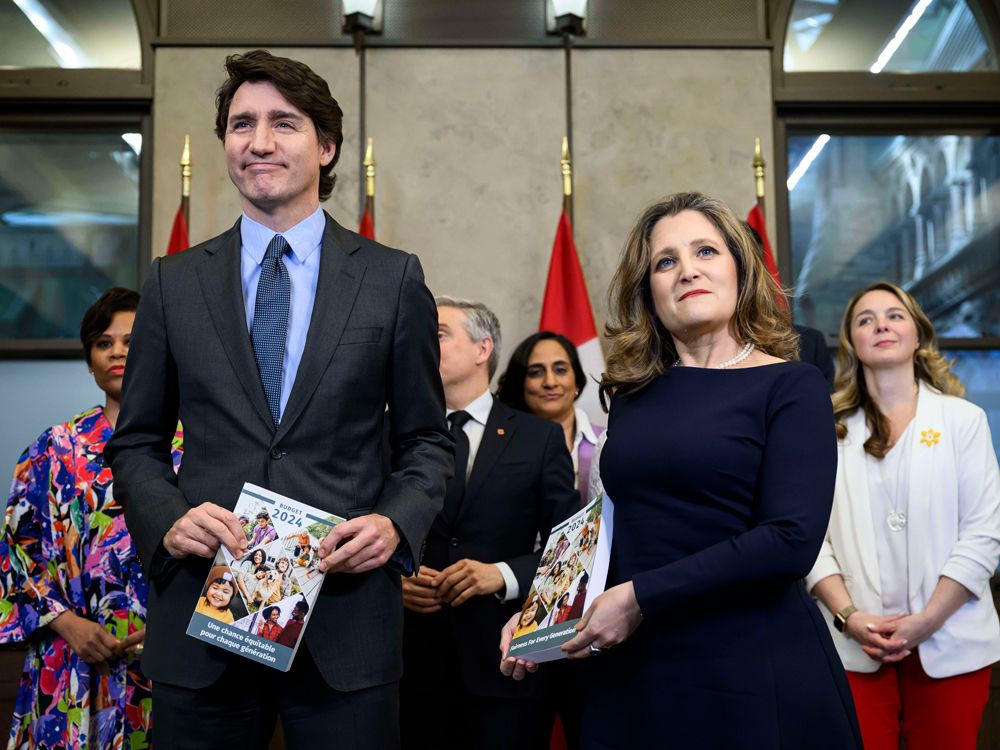Economy
Politicians who consider sacrificing the old for the sake of the economy face a backlash: Don Pittis – CBC.ca

Those who say the value of human life cannot be measured may not know one of the dark secrets of economics.
As we hear about the monstrous death rates from COVID-19 in Italy and Spain, we must face the fact that whenever there is a cost to keeping people from dying — whether in traffic accidents or from rare diseases — there is always a trade-off.
According to the calculations of economists, human life does, indeed, have a price.
And after Texas Lt.-Gov. Dan Patrick suggested it may be time for grandma and grandpa to risk sacrificing themselves for the economy, it is inevitable that those of us approaching the cut-off date may be getting a little nervous.
“As a senior citizen, are you willing to take a chance on your survival, in exchange for keeping the America that all America loves for your children and grandchildren? And if that’s the exchange, I’m all in,” said Patrick, 70, this week in a much-quoted and much-shared clip from Fox News.
Texas Lt Governor Dan Patrick: Grandparents/seniors should be willing to die from <a href=”https://twitter.com/hashtag/coronavirus?src=hash&ref_src=twsrc%5Etfw”>#coronavirus</a> to maintain the economy. <br><br>Where do jerks like him come from? <a href=”https://t.co/sTNSzCjbct”>pic.twitter.com/sTNSzCjbct</a>
—@TalbertSwan
It brings to mind Christopher Buckley’s satiric novel Boomsday, in which baby boomers are paid cash up front to commit to being bumped off when they reach age 75 in order to save money for younger taxpayers.
A character in the 2007 book remarks it’s “the fate of many propositions to begin as heresies and end as truths.”
If Patrick is to be taken at his word, suddenly, that economic heresy may be coming to life.
The human life calculator
Of course, reports show the new coronavirus does not just kill old people.
But with death rates for those who catch it rising with age to as high as one in five after age 80, there’s been a backlash.
Essentially, critics say similar statements by U.S. President Donald Trump — to the effect that the country needs to go back to work soon to restart the economy — will likely lead to hundreds of thousands of additional deaths.
“We cannot let the cure be worse than the problem itself,” Trump tweeted in capital letters.
As Chris Fievoli from the Canadian Institute of Actuaries said Wednesday, there is no question in the insurance industry that lives have measurable value. He recalls working in the 1980s, when the AIDS epidemic was killing young people, and each young life lost cost the industry more than if they had been able to grow old.
The insurance industry has this handy widget called the Human Life Value Calculator intended to show how much life insurance you need, but which also shows a decline in value in senior years.
COVID-19 crisis has brought out the ageists
Similarly, various government agencies, including the U.S. Environmental Protection Agency, have estimates for how much should be spent to protect people from hazards. According to the New York Times, the EPA’s estimate is $9.5 million US per life saved.
In the 1990s, the agency tried to include a provision that the lives of people over 70 were only worth two-thirds of those of younger people before being scared off by AARP, the U.S. lobby group for older people.
Here in Canada, Marissa Lennox, chief policy officer for CARP, AARP’s northern sister organization, is outraged by what she sees as an increase in bias against older people caused by the new pandemic.
“I think COVID-19 has brought the ageists out in force,” said Lennox. She deplores the use of the phrase “boomer remover” that she says has swept social media.
WATCH | U.S. President Donald Trump is anxious to get the economy running again:
Even worse, she says, some medical authorities around the world are discussing putting an age limit on who gets treatment, which she sees as an implication that seniors are expendable.
Comments like Trump’s and Patrick’s, she warns, may be a slippery slope.
“Any rhetoric around sacrificing the ‘old’ for the sake of the economy is purely ageist, and it is dangerous,” said Lennox.
Caring for the elderly has a cost
As Buckley’s satire Boomsday laid out clearly that caring for the old has a public cost, especially in the U.S. where pensions remain an unfunded government liability. Here in Canada, most pensions come out of a fund based on your lifetime contributions.
But sacrificing the weak and old has a cost, too, leaving each of us wondering which group will be next.
“The true measure of any society can be found in how it treats its most vulnerable members,” Indian civil rights leader Mahatma Gandhi reportedly said, an idea that clearly represents a different kind of economic calculus.
Rather than being based on dollars and cents, it is a social contract in which the more active and wealthy work to support the more vulnerable. After all, as Lennox points out, most of us will eventually need the help of a caring society.
“One of the things we love about CARP members is how much they love their children and their grandchildren,” said Lennox. “And I would hope those children and grandchildren feel the same.”
But even if politicians don’t care about the idea of a social contract, they may be inclined to listen, because repeated studies show that old people vote and the young don’t.
Follow Don on Twitter @don_pittis
Economy
Canada's budget 2024 and what it means for the economy – Financial Post


THIS CONTENT IS RESERVED FOR SUBSCRIBERS ONLY
Subscribe now to read the latest news in your city and across Canada.
- Exclusive articles from Barbara Shecter, Joe O’Connor, Gabriel Friedman, Victoria Wells and others.
- Daily content from Financial Times, the world’s leading global business publication.
- Unlimited online access to read articles from Financial Post, National Post and 15 news sites across Canada with one account.
- National Post ePaper, an electronic replica of the print edition to view on any device, share and comment on.
- Daily puzzles, including the New York Times Crossword.
SUBSCRIBE TO UNLOCK MORE ARTICLES
Subscribe now to read the latest news in your city and across Canada.
- Exclusive articles from Barbara Shecter, Joe O’Connor, Gabriel Friedman, Victoria Wells and others.
- Daily content from Financial Times, the world’s leading global business publication.
- Unlimited online access to read articles from Financial Post, National Post and 15 news sites across Canada with one account.
- National Post ePaper, an electronic replica of the print edition to view on any device, share and comment on.
- Daily puzzles, including the New York Times Crossword.
REGISTER / SIGN IN TO UNLOCK MORE ARTICLES
Create an account or sign in to continue with your reading experience.
- Access articles from across Canada with one account.
- Share your thoughts and join the conversation in the comments.
- Enjoy additional articles per month.
- Get email updates from your favourite authors.
Economy
Opinion: Canada's economy has stagnated despite Trudeau government spin – Financial Post
Article content
Growth in gross domestic product (GDP), the total value of all goods and services produced in the economy annually, is one of the most frequently cited indicators of economic performance. To assess Canadian living standards and the current health of the economy, journalists, politicians and analysts often compare Canada’s GDP growth to growth in other countries or in Canada’s past. But GDP is misleading as a measure of living standards when population growth rates vary greatly across countries or over time.
Article content
Federal Finance Minister Chrystia Freeland recently boasted that Canada had experienced the “strongest economic growth in the G7” in 2022. In this she echoes then-prime minister Stephen Harper, who said in 2015 that Canada’s GDP growth was “head and shoulders above all our G7 partners over the long term.”
Article content
Unfortunately, such statements do more to obscure public understanding of Canada’s economic performance than enlighten it. Lately, our aggregate GDP growth has been driven primarily by population and labour force growth, not productivity improvements. It is not mainly the result of Canadians becoming better at producing goods and services and thus generating more real income for their families. Instead, it is a result of there simply being more people working. That increases the total amount of goods and services produced but doesn’t translate into increased living standards.
Let’s look at the numbers. From 2000 to 2023 Canada’s annual average growth in real (i.e., inflation-adjusted) GDP growth was the second highest in the G7 at 1.8 per cent, just behind the United States at 1.9 per cent. That sounds good — until you adjust for population. Then a completely different story emerges.
Article content
Over the same period, the growth rate of Canada’s real per person GDP (0.7 per cent) was meaningfully worse than the G7 average (1.0 per cent). The gap with the U.S. (1.2 per cent) was even larger. Only Italy performed worse than Canada.
Why the inversion of results from good to bad? Because Canada has had by far the fastest population growth rate in the G7, an average of 1.1 per cent per year — more than twice the 0.5 per cent experienced in the G7 as a whole. In aggregate, Canada’s population increased by 29.8 per cent during this period, compared to just 11.5 per cent in the entire G7.
Starting in 2016, sharply higher rates of immigration have led to a pronounced increase in Canada’s population growth. This increase has obscured historically weak economic growth per person over the same period. From 2015 to 2023, under the Trudeau government, real per person economic growth averaged just 0.3 per cent. That compares with 0.8 per cent annually under Brian Mulroney, 2.4 per cent under Jean Chrétien and 2.0 per cent under Paul Martin.
Recommended from Editorial
Canada is neither leading the G7 nor doing well in historical terms when it comes to economic growth measures that make simple adjustments for our rapidly growing population. In reality, we’ve become a growth laggard and our living standards have largely stagnated for the better part of a decade.
Ben Eisen, Milagros Palacios and Lawrence Schembri are analysts at the Fraser Institute.
Bookmark our website and support our journalism: Don’t miss the business news you need to know — add financialpost.com to your bookmarks and sign up for our newsletters here.
Share this article in your social network
Economy
Federal budget is about ensuring fair economy for ‘everyone’: Trudeau – Global News


Delivering remarks to his Liberal cabinet during a caucus meeting on Wednesday, Prime Minister Justin Trudeau emphasized that the newly-announced federal government is intended to help create a fair economy for “everyone” in Canada, particularly those from Millennials and Gen Z.
-



 Sports20 hours ago
Sports20 hours agoTeam Canada’s Olympics looks designed by Lululemon
-
News21 hours ago
Richard Chevolleau Short Film “Marvelous Marvin” Set to go to Camera
-
Business19 hours ago
Firefighters battle wildfire near Edson, Alta., after natural gas line rupture – CBC.ca
-



 Tech12 hours ago
Tech12 hours agoiPhone 15 Pro Desperado Mafia model launched at over ₹6.5 lakh- All details about this luxury iPhone from Caviar – HT Tech
-



 Investment22 hours ago
Investment22 hours agoStephen Poloz will lead push to boost domestic investment by Canadian pension funds
-
Art23 hours ago
Richmond art exhibits travel back in time, explore legacies
-
News22 hours ago
Federal budget 2024: Some of the winners and losers
-



 Sports12 hours ago
Sports12 hours agoLululemon unveils Canada's official Olympic kit for the Paris games – National Post








